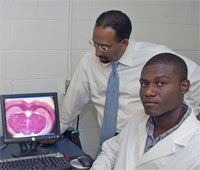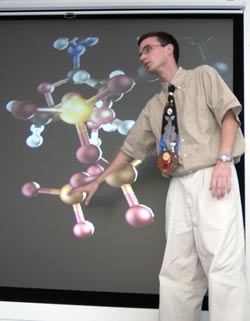Kingston resident Yuzuru Shimizu to be feted KINGSTON, R.I. — July 6, 2005 — How do you celebrate the 70th birthday of a University of Rhode Island professor who is renowned for his research on obtaining drugs from the sea? You simply invite his colleagues, friends and former students from around the world to a […]
Continue reading "URI to host conference, birthday bash in honor of ‘drugs from the sea’ pioneer"University awarded $750,000 NSF alliance grant
URI to boost the ranks of minority science, engineering professors KINGSTON, R.I. — July 1, 2005 — Growing up in South Carolina, Brian Brock was always intrigued by science. It’s a family legacy since his mother taught high school science. Today Brock is pursuing a master’s degree in pharmacology and toxicology at the University of […]
Continue reading "University awarded $750,000 NSF alliance grant"URI pharmacy students teach local children about dangerous substances
A prescription for a healthy future KINGSTON, R.I. — May 24, 2005 — South Kingstown elementary school children learned some important lessons about poisons and cigarettes thanks to University of Rhode Island College of Pharmacy students. The URI students visited classes at the South Road School this spring as part the College’s annual outreach program […]
Continue reading "URI pharmacy students teach local children about dangerous substances"URI College of Pharmacy joins forces with West Warwick firm to make medical records available in emergencies
An elderly woman in Woonsocket suffers a heart attack and is rushed to the hospital. KINGSTON, R.I. — May 2, 2005 –The area hospital has some of her records because she has been treated there before, but she has been seeing specialists in Providence and Boston. How can medical professionals retrieve information about her prescribed […]
Continue reading "URI College of Pharmacy joins forces with West Warwick firm to make medical records available in emergencies"URI announces 2005 student leadership awards
KINGSTON, R.I. — April 22, 2005 — Last week, the University of Rhode Island celebrated the achievements of several students who have taken on leadership roles in the community while also maintaining their solid academic records. A leading student athlete, the head lifeguard at URI’s Tootell Aquatic Center, and the College of Pharmacy Student Leadership […]
Continue reading "URI announces 2005 student leadership awards"Perinatal Soup—Early Pathogen or Toxin Exposures Leave Brain Vulnerable
14 February 2005. Scientists have little trouble accepting the idea that ontogeny is a process rich in interplay between genetic and environmental factors, or that environmental insults ranging from malnutrition to toxins during the embryonic and early postnatal periods can harm development. But what about the argument that environmental insults suffered early in life could […]
Continue reading "Perinatal Soup—Early Pathogen or Toxin Exposures Leave Brain Vulnerable"URI students demonstrate powerful animation tools for study of complex biomedical processes
$100,000 Champlin Foundations grant provides latest animation technology KINGSTON, R.I. — October 27, 2004 — Powerful computer technology made possible the creation of such animated film hits as Shrek and Finding Nemo. Now, thanks to a $100,000 grant from the Champlin Foundations, the University of Rhode Island College of Pharmacy has similar computer animation technology […]
Continue reading "URI students demonstrate powerful animation tools for study of complex biomedical processes"Rho Chi Pharmacy Honor Society
Rho Chi is dedicated to a dual purpose: Our first aim is to promote the advancement of the pharmaceutical sciences and the profession of pharmacy. Our second aim is to foster good fellowship among members for it is only by organized efforts and cooperative action that our first aim can be accomplished.
Continue reading "Rho Chi Pharmacy Honor Society"Student National Pharmaceutical Association
SNPhA is an educational service association for pharmacy students who are concerned about pharmacy issues and the poor minority representation health-related professions. The purpose of SNPhA is to execute programs geared toward the improvement of the health of the community.
Continue reading "Student National Pharmaceutical Association"






